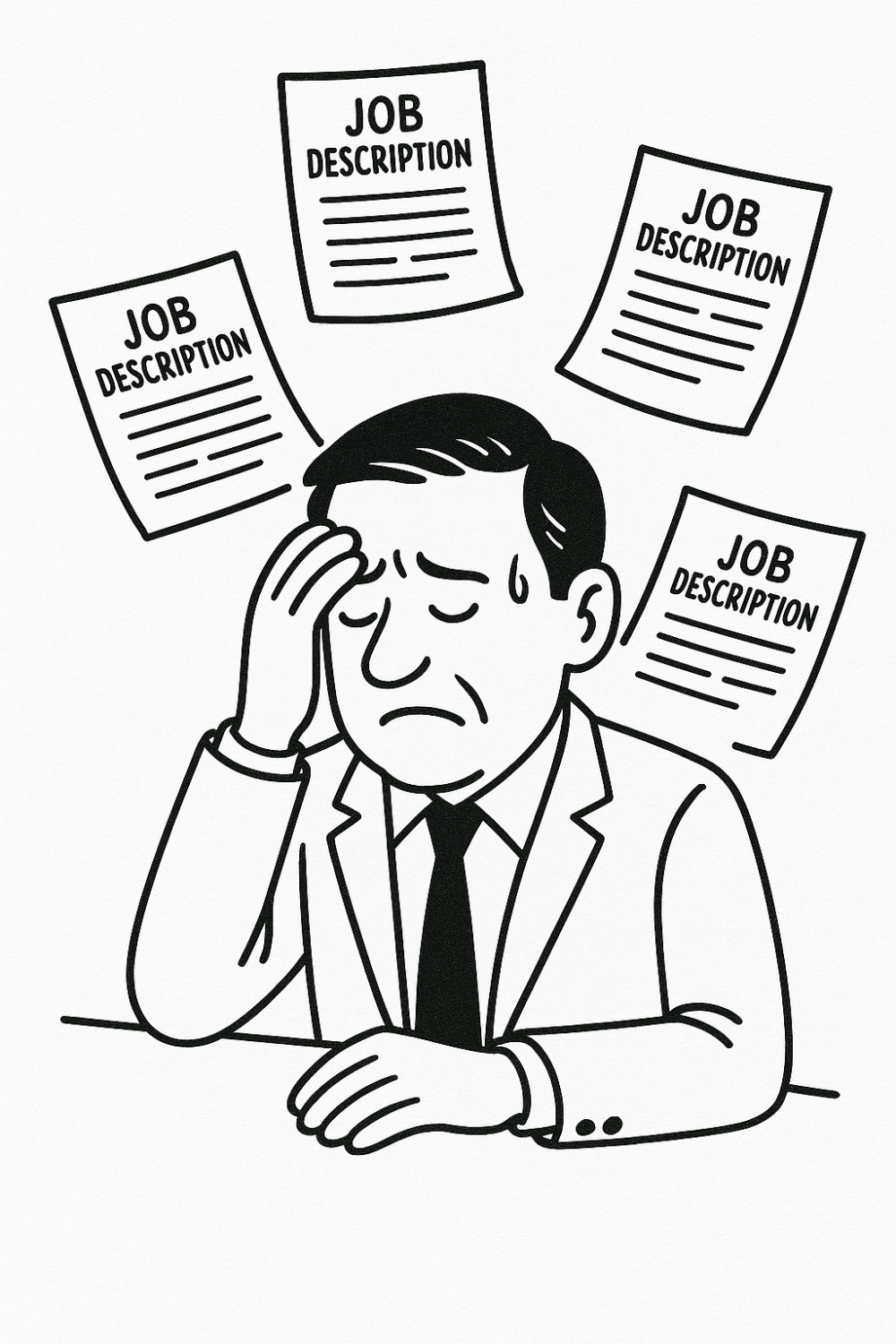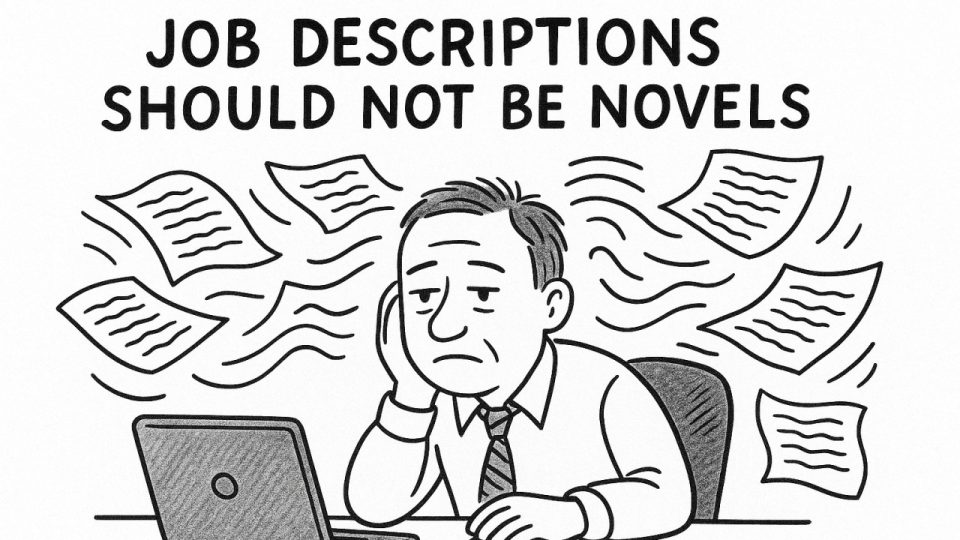We were asked to revise a set of job descriptions. Ten pages each. Ten!
By page three I felt like I was reading a mash-up of the Labor Code, an org chart and a company policy handbook. Except it was all glued together under the title “Job Description.”
This is NOT unusual. I have done hundreds of JD projects and the pattern is painfully repetitive:
- Duplication everywhere.
- Clauses that belong in SOPs, contracts, or regulations.
- Lists so long they make you forget what job you’re even reading about.
Instead of clarifying the role, these JDs do the opposite. They bury the essence under noise. Employees do not read them, managers do not use them and HR keeps them in folders like museum artifacts.
Why long JDs fail (and why they are written anyway)
The logic behind 10-page JDs is usually fear. Fear of leaving something out. Fear of being blamed if the “wrong” task is not written. Fear of auditors. And ISO standards do not help here either.
So companies try to solve fear with paper. They add line after line, clause after clause. The result? A document that looks serious but says nothing.
Let us break it down:
- They duplicate the org chart. If your JD spends two pages explaining “reports to Director of X, supervises Y, coordinates with Z,” you have just printed your org chart twice. Everyone can already see who reports to whom.
- They copy-paste SOPs. Standard operating procedures describe how processes work. JDs describe what problem the role solves. Mixing the two is like mixing IKEA instructions with a love letter – confusing, boring and nobody wants to read it.
- They repeat employment contracts. Every JD I see contains phrases like: “The employee is obliged to respect company policies and internal regulations.” That is what contracts are for. Writing it again in a JD does not make it truer, it only makes the JD weaker.
- They over-detail tasks. “Attend meeting. Write notes. Send recap.” That is not a JD, that is a personal to-do list. A role is not 40 tasks. A role is a problem to solve, a space to own, a set of decisions to make.
- They miss the strategy link. Worst of all, most long JDs do not connect to the company’s strategy. They describe busyness, not impact. People read them and still can not answer: “Why does my role matter for the bigger picture?”

The hidden cost of bad JDs
It is not just about boring paperwork. Bad JDs actually make performance worse.
Why? Because they live in isolation.
- The JD says one thing.
- The performance evaluation measures another.
- The development plan goes in a third direction.
- Strategy KPIs live in another file altogether.
When JDs are disconnected, you end up with chaos: employees confused, managers improvising, HR frustrated.
I often see managers struggle during evaluations: “How do I rate them? Half of what is in the JD is irrelevant, the important things are not even written here.” Exactly. Because the JD became a dumping ground, not a roadmap.
What a JD should actually be
A JD is not a formality. It is a strategic tool. Done right, it connects three layers:
- Development: the skills and knowledge this role must bring and grow.
- Deliverables: the objectives and measurable results of the role.
- Strategy: how the role contributes to organizational effectiveness (KPI, OKR or other functional outcomes, you name it).
When these three are clear, the JD becomes alive. It guides employees, supports managers in evaluation, and links HR with business results.
The 2-Page JD Model
Here is the structure I propose (and apply):
- Job Objective – one clear sentence: What problem does this role solve for the company?
- Responsibility Areas – 4–6 domains of ownership (not 27 micro-tasks)
- Key Decisions – 3–5 recurring choices the role makes, with limits.
- Communication & Interfaces – who they report to, who they work with, who depends on their output.
That is it. Two pages. Enough to guide daily work and connect to long-term performance.

Why less is more: five reasons
1. Nobody reads 10 pages. Employees are not lawyers. If a JD takes longer to read than a Netflix episode, it will never be used.
2. Tasks change, objectives do not. Today it is Excel, tomorrow it is AI dashboard. By writing tasks, you guarantee chaos. By writing objectives, you guarantee relevance.
3. Decisions create accountability. If your JD only says “prepare” and “assist,” the person stays busy but powerless. Real accountability comes when the JD names decisions.
4. Responsibility areas = freedom. “Responsible for cross-team communication flow” is empowering. “Attend weekly meeting, send report, file agenda” is nonsense.
5. Duplications kill importance. Every time you repeat SOPs, contracts, or the org chart inside the JD, you make it weaker. Important parts drown in noise. Imagine shouting strategy while a parrot repeats “employee must respect internal regulations.”
From my projects
Across industries — banking, telecom, IT, manufacturing, reatail, NGOs, I see the same story:
- Duplication. The JD repeats what already exists elsewhere.
- Decoration. It looks formal but delivers no clarity.
- Disconnection. It lives separately from evaluation and strategy.
And the effect is universal: employees dol not know where their job starts and ends. Managers drown in decisions that should be made below them. HR spends time updating documents nobody reads.
When we shift to the 2-page model, the conversation changes. Suddenly the JD:
- Anchors performance evaluations.
- Guides development (skills/knowledge inventory).
- Links roles directly to strategy.
That’s when a JD stops being paperwork and starts being a compass.

Metaphors to keep in mind
- A 10-page JD is like IKEA instructions without pictures: lots of text, no idea what you are building.
- A long JD is like a parrot repeating the contract and SOP: noisy, boring, and distracting.
- A good JD is like a compass: simple, clear, always showing direction.
So here is my blunt truth: 10-page job descriptions look impressive, but they are noise. They duplicate, repeat, and confuse. Two pages with the right structure create clarity, accountability, and alignment.
Because a JD is not just HR paperwork. It is strategy in practice.
Next time you open a JD, ask yourself – is this a roadmap or just ten pages of legal karaoke?
